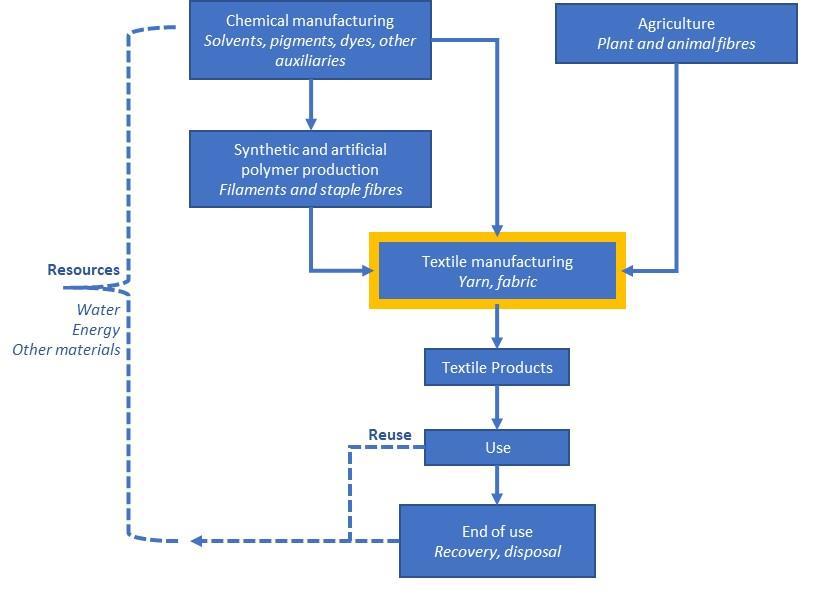
4 minute read
Figure 8. Textile Manufacturing Flow Diagram
from Value chain approaches to determining Best Available Techniques (BAT) for industrial installations
by OECD
3. ANALYSIS OF BAT EFFECTIVENESS FROM A VALUE CHAIN PERSPECTIVE 31
Figure 8. Textile Manufacturing Flow Diagram
These issues may be addressed in BAT regulations for the textile manufacturing industry. Relevant regulations include: The 2019 draft EU BREF document for the textiles industry6 scope includes some of the textile value chain, including yarn and fabric production, pre-treatment (washing, mercerizing, bleaching, etc.), dyeing, fabric printing, coating, finishing, and lamination. Additionally, certain aspects of wool textile production are also covered, including wool scouring, carbonizing, and fulling. Selected activities related to waste management are also covered (EIPPCB, 2019[42]).
7 The US technology-based standards8 for air emissions from the textiles sector cover web coating and printing, slashing, and dyeing, and finishing as three separate subcategories. New or reconstructed facilities must also comply with polymeric coating standards to woven, knit, and nonwoven textiles as well as cord and yarn. Standards for discharges to water cover wool scouring and finishing, low water use processing, woven fabric finishing, knit fabric finishing, carpet finishing stock and yarn finishing, nonwoven textile manufacturing, and felted fabric processing. The Russian BREF document9 for the textiles industry focuses on pre-treatment, dyeing, printing, and finishing process while other upstream activities including yarn and fabric productions are briefly described (Rosstandart, 2017[43]). The Korean BREF for the textile industry also focuses primarily on pre-treatment, dyeing, and the other finishing process (NIER, 2019[44]). The above documents and regulations address the textile value chain in various ways. Strategies for addressing the environmental impacts from textile production often include chemical selection and increasing processing efficiency. Assessment of textile-related BREFs show instances where solutions from other links in the value chain were considered in addressing environmental issues from the textiles industry.
BEST AVAILABLE TECHNIQUES (BAT) FOR PREVENTING AND CONTROLLING INDUSTRIAL POLLUTION © OECD 2022
32 3 ANALYSIS OF BAT EFFECTIVENESS FROM A VALUE CHAIN PERSPECTIVE
Related to upstream considerations, The draft EU BREF for the textiles industry specifies use of fibres and filaments with minimal contamination from pesticides, manufacturing residues, mineral oils, and sizing chemicals. In order to verify minimal contamination, BAT is to monitor incoming contaminants through in-house testing, coordination with suppliers, or certification schemes and standards. Concerning chemical use and management, the draft EU BREF for the textiles industry specifies that “procurement policy [is] to select process chemicals and their suppliers with the aim to minimise the use of hazardous chemicals. BAT also includes careful charting of movement of chemicals through the facility, from procurement to products, waste, and releases to the environment. Additionally, it is BAT to use textile material with low content of contaminants (pesticides, manufacturing residues) and facilities should establish a system to return unused process chemicals to suppliers (EIPPCB, 2019[42]). US BAT regulations consider the substitutions of sulphur dyes and phenolic dye carriers for safer alternatives when establishing discharge limits for sulphide and total phenols. The US National Emission Standards for Hazardous Air Pollutants (NESHAP) for printing, coating, and dyeing of fabrics and other textiles allows for a “compliant material option,” where facilities may demonstrate that purchased coatings or printing material has an organic hazardous air pollutant (HAP) content less than or equal to the relevant emission limit. Additionally, cleaning and thinning materials may contain no hazardous organic pollutants. Facilities must demonstrate that materials meet these standards as purchased, encouraging collaboration with upstream suppliers to minimize HAP content in incoming materials. Korean BAT 8 focuses on chemical substitutions including the use of less harmful and biodegradable surfactants, sequestering agents, and antifoaming agents. These substitutions can reduce the load of downstream wastewater treatment and may prevent chemical residues in product (NIER, 2019[44]). Relating to resource efficiency, BAT Conclusions also specify use of textile materials with ‘inherent characteristics’ which require less processing in order to maximize resource efficiency and minimise the use of hazardous substances. The draft EU BREF for the textiles industry provides additional details on the cationisation process, including a brief description of potential discharges to water as cross media effects (EIPPCB, 2019[42]). While the draft EU BREF for the textiles industry seeks to maintain flexibility by considering wet processes as individual units rather than linked operations, it is useful to note that BAT 9 for water use and waste water generation dictates that production optimization occur to ensure that combined processes (and their scheduling) are considered holistically to minimize water consumption and waste water generation. Additionally, techniques for water reuse and recycling are outlined to ensure maximum resource efficiency (EIPPCB, 2019[42]). Korean, EU, and Russian BREFs include recovery of sizing agents in desizing processes or caustic soda in mercerizing processes for later reuse, both of which increase the resource efficiency, i.e., production volume per auxiliary input (NIER, 2019[44]) (EIPPCB, 2019[42]) (Rosstandart, 2017[43]). Certain environmental issues impacting or resulting from the industry sector may not be sufficiently addressed in guidance. Review of other BREF documents from up- and downstream sectors show instances where environmental issues stemming from the textiles industry were considered. The fine chemical manufacturing is the upstream supplier of dyes to the textile industry. The draft EU BREF for the textiles industry contains a wealth of information on dyes and dyeing, including information about dye classes, toxicity, and use of auxiliaries. In general, the draft BREF considers use of dyes with minimal toxicity and superior fixation and fastness as BAT. While the EU Organic
BEST AVAILABLE TECHNIQUES (BAT) FOR PREVENTING AND CONTROLLING INDUSTRIAL POLLUTION © OECD 2022





